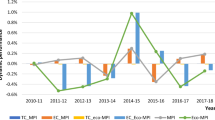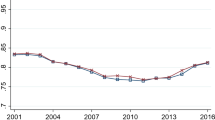Abstract
The water industry encompasses a wide variety of water companies operating with different production technologies. This study evaluated and compared changes to the productivity of several fully private water companies (FPWCs) and concessionary water companies (CWCs). Specifically, the cost Malmquist productivity index was estimated by integrating inputs, outputs and environmental variables. A non-parametric approach was used by applying data envelopment analysis. This approach allowed us to quantify the parameters driving changes to productivity as cost efficiency change (technical and allocative efficiency), cost scale efficiency and cost technical change (technical change and input price effect). Through breaking down the cost Malmquist productivity index, relevant information for supporting decision making process by water companies is possible. To further evaluate the impact of water company heterogeneity on productivity change, the changes (convergence versus divergence) to productivity between group and meta-frontiers was estimated. The approach was applied empirically on a sample of 22 water companies in Chile during 2010–2017. The results showed that the productivity of both FPWCs and CWCs improved over time, with FPWCs performing better compared to CWCs. The main drivers of productivity growth for both types of water companies were scale efficiency, technical efficiency and input price effect. Thus, water companies in Chile could improve productivity by moving to a cost-efficient allocation of their resources. The rate of productivity convergence was higher for CWCs compared to FPWCs. The approaches developed in this study provide information that could be used by water managers to better understand what drives productivity and, thus, delineate strategies to improve performance over time.



Similar content being viewed by others
Data Availability
The datasets generated and/or analysed during the current study are not publicly available due they were developed from primary sources of data but are available from the corresponding author on reasonable request.
Notes
Interested readers can consult the SISS website at: www.siss.gob.cl
References
Battese GE, Rao DSP, O’Donnell CJ (2004) A meta-frontier production function for estimation of technical efficiencies and technology gaps for firms operating under different technologies. J Product Analysis 21:91–103
Berg S, Marques R (2011) Quantitative studies of water and sanitation utilities: a benchmarking literature survey. Water Policy, 13 (5), 591–606. Bogetoft, P., Otto, L. (2011). Benchmarking with DEA, SFA, and R. New York: Springer Science & Business Media
Cetrulo TB, Marques RC, Malheiros TF (2019) An analytical review of the efficiency of water and sanitation utilities in developing countries. Water Research161, pp. 372-380
Cetrulo TB, Ferreira DF, Marques RC, Malheiros TF (2020) Water utilities performance analysis in developing countries: On an adequate model for universal access. J Environ Manag 268, 110662
Cho TY (2018) Cost metafrontier approach for measuring the Malmquist productivity index: An example of bank groups formed after the financial reform in Taiwan. Pacific Econ Rev 1–20
Coelli T, Gautier A, Perelman S, Saplacan-Pop R (2013) Estimating the cost of improving quality in electric distribution: a parametric distance function approach. Energy Policy 53:287–297
Correira T, Marques RC (2011) Performance of Portuguese water utilities: how do ownership, size, diversification and vertical integration relate to efficiency? Water Policy 13:343–361
De Witte K, Marques RC (2009) Capturing the environment, a metafrontier approach to the drinking water sector. Intern Transact Operation Res 16(2):257–271
Erbetta F, Petraglia C (2011) Drivers of Regional Efficiency Differentials in Italy: Technical Inefficiency or Allocative Distortions? Growth Change 42(3):351–375
Goh KH, See KF (2021) Twenty years of water utility benchmarking: A bibliometric analysis of emerging interest in water research and collaboration. J Clean Prod 284, 124711
Hayami Y (1969) Sources of agricultural productivity gap among selected countries. American Journal of Agricultural Economics 51(3):564–575
Hayami Y, Ruttan VW (1970) Agricultural productivity differences among countries. Am Econ Rev 895–911
Higuerey A, Trujillo L, González MM (2017) Has efficiency improved after the decentralization in the water industry in Venezuela? Util Policy 49:127–136
Huang CJ, Huang TH, Liu NH (2014) A new approach to estimating the metafrontier production function based on a stochastic frontier framework. J Product Analysis 42:241–254
Huang MY, Juo JC, Fu TT (2015) Metafrontier cost Malmquist productivity index: An application to Taiwanese and Chinese commercial banks. J Product Analysis 44:321–335
Li F, Phillips MA (2017) The Influence of the Regulatory Environment on Chinese Urban Water Utilities. Water Resour Manage 31:205–218
Maniadakis N, Thanassoulis E (2004) A cost Malmquist productivity index. Euro J Operation Res 154:396–409
Marques RC (2011) Regulation of Water and Wastewater Services: An International Comparison. IWA Publishing, London (United Kingdom)
Marques RC, Berg S, Yane S (2014) Nonparametric benchmarking of Japanese water utilities: Institutional and environmental factors affecting efficiency. J Water Resour Plan Manag 140(5):562–571
Mellah T, Ben Amor T (2016) Performance of the Tunisian Water Utility: An input distance function approach. Util Policy 38:18–32
Molinos-Senante M, Maziotis A (2019) Cost Efficiency of English and Welsh Water Companies: a Meta-Stochastic Frontier Analysis. Water Resour Manag 33:3041–3055
Molinos-Senante M, Maziotis A, Sala-Garrido R (2017) Assessing the productivity change of water companies in England and Wales: a dynamic metafrontier approach. J Environ Manag 197:1–9
Molinos-Senante M, Sala-Garrido R (2016) Performance of fully private and concessionary water and sewerage companies: a metafrontier approach. Environ Sci Pollut Res 23:11620–11629
O’Donnell CJ, Rao P, Battese GE (2008) Metafrontier frameworks for the study of firm-level efficiencies and technology ratios. Emp Econ 34:231–255
Romano G, Guerrini A, Marques RC (2017) European Water Utility Management: Promoting Efficiency, Innovation and Knowledge in the Water Industry. Water Resour Manage 31:2349–2353
Sala-Garrido R, Molinos-Senante M, Mocholi-Arche M (2019) Comparing changes in productivity among private water companies integrating quality of service: A metafrontier approach. J Clean Prod 216:597–606
See KF (2015) Exploring and analysing sources of technical efficiency in water supply services: Some evidence from Southeast Asian public water utilities. Water Resour Econ 9:23–44
Suárez-Varela M, García-Valiñas M, González-Gómez F, Picazo-Tadeo AJ (2017) Ownership and performance in water services revisited: does private management really outperform public? Water Resour Manag 31(8):2355–2373
Wang Q, Zhang H, Zhang W (2013) A Malmquist CO2 emission performance index based on a metafrontier approach. Math Com Model 58(5–6):1068–1073
Author information
Authors and Affiliations
Contributions
AM: Conceptualization; data curation; validation; writing-original draft; methodology; software.
RSG: Methodology; software; writing-review & editing.
MMA: Methodology; software; writing-review & editing.
MMS: Project administration; resources; writing-review & editing; Formal analysis.
Corresponding author
Ethics declarations
Ethical Approval
This manuscript has been developed in compliance with Ethical Standards.
Competing Interests
The authors declare that they have no competing interests.
Additional information
Publisher's Note
Springer Nature remains neutral with regard to jurisdictional claims in published maps and institutional affiliations.
Supplementary Information
Below is the link to the electronic supplementary material.
Rights and permissions
About this article
Cite this article
Maziotis, A., Sala-Garrido, R., Mocholi-Arce, M. et al. Changes to The Productivity of Water Companies: Comparison of Fully Private and Concessionary Water Companies. Water Resour Manage 35, 3355–3371 (2021). https://doi.org/10.1007/s11269-021-02897-1
Received:
Accepted:
Published:
Issue Date:
DOI: https://doi.org/10.1007/s11269-021-02897-1




